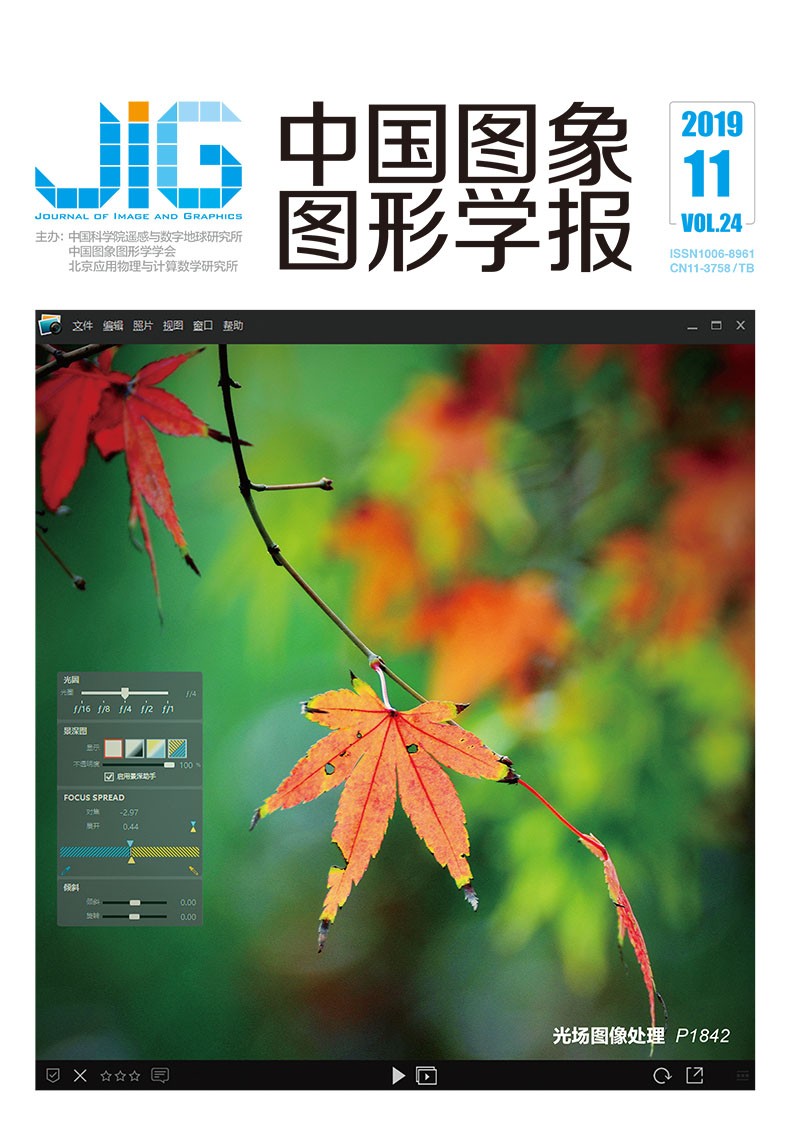
采用训练策略实现的快速噪声水平估计
摘 要
目的 大多数图像降噪算法都属于非盲降噪算法,其获得良好降噪性能的前提是能够准确地获知图像的噪声水平值。然而,现有的噪声水平估计(NLE)算法在噪声水平感知特征(NLAF)提取和噪声水平值映射两个核心模块中分别存在特征描述能力不足和预测准确性有待提高的问题。为此,提出了一种基于卷积神经网络(CNN)自动提取NLAF特征,并利用增强BP (back propagation)神经网络将其映射为相应噪声水平值的改进算法。方法 在训练阶段,首先通过训练卷积神经网络模型并以全连接层中若干与噪声水平值相关系数较高的输出值构成NLAF特征矢量;然后,在AdaBoost技术的支撑下,利用多个映射能力相对较弱的BP神经网络构建一个非线性映射能力更强的增强BP神经网络预测模型,将NLAF特征矢量直接映射为噪声水平值。在预测阶段,首先从给定噪声图像中随机选取若干个图块输入到卷积神经网络模型中,提取每个图块的若干维NLAF特征值后,利用预先训练的BP网络模型将其映射为对应的噪声水平值,然后以估计值的中值作为图像噪声水平值的最终估计结果。结果 对于具有不同噪声水平和内容结构的噪声图像,利用所提算法估计出的噪声水平值与真实值之间的估计误差小于0.5,均方根误差小于0.9,表现出良好的预测准确性和稳定性。此外,所提算法具有较高的执行效率,估计一幅512×512像素的图像的噪声水平值仅需约13.9 ms。结论 实验数据表明,所提算法在高、中、低各个噪声水平下都具有稳定的预测准确性和较高的执行效率,与现有的主流噪声水平估计算法相比综合性能更佳,可以很好地应用于要求噪声水平作为关键参数的实际应用中。
关键词
Fast noise level estimation algorithm adopting training strategy
Xu Shaoping, Lin Zhenyu, Li Chongxi, Liu Tingyun, Yang Xiaohui(School of Information Engineering, Nanchang University, Nanchang 330031, China) Abstract
Objective Image denoising is a fundamental but challenging problem in low-level vision and image processing. Most existing image-denoising methods can be classified as so-called non-blind approaches, which are assumed to work under the premise of the availability of noise level. Thus, their denoising performance highly depends on the accuracy of the noise level fed into them. In practice, however, noise level is always unknown beforehand. As a result, fast and accurate noise level estimation (NLE) is often necessary for blind image denoising. To date, training-based NLE methods using handcrafted features that reflect the distortion level of a noisy image, i.e., noise level-aware features (NLAFs), still suffer from the weak ability of feature description and the low accuracy of nonlinear mapping in NLAF extraction and noise level-mapping modules, respectively. To this end, an NLE algorithm that automatically extracts NLAFs with a convolutional neural network (CNN) and directly maps the NLAFs to their corresponding noise level using AdaBoost backpropagation (BP) neural network was proposed. Method Substantially clean images were first corrupted with Gaussian noise at different noise levels to form a set of noisy images. The noisy patches extracted from the noisy images and their corresponding noise levels were then fed into a CNN to train a CNN-based NLE model. However, the CNN-based NLE model directly used to obtain the noise level of a noisy image had poor estimation accuracy. The major reasons were as follows: 1) no strong correlation between most of the output values of the fully connected layer of the CNN-based NLE model and the noise levels, and 2) an inadequate nonlinear mapping ability of the regression layer used to predict noise level in the CNN-based NLE model. Therefore, the correlation between the output values of the fully connected layer and the ground truths was analyzed and then several outputs that had higher correlation coefficient with the ground-truth noise levels were selected as the NLAFs in the form of feature vector. With the support of the AdaBoost technique, multiple BP neural networks with relative weak mapping ability were combined to build a strong nonlinear mapping prediction model, i.e., enhanced BP network, and the obtained prediction model was used to map the extracted NLAFs to their corresponding noise level directly. In the prediction phase, given a noisy image to be denoised, several patches were first randomly extracted and then fed into the trained CNN-based NLE model. Next, several NLAFs were extracted from the fully connected layer of the CNN-based model. The extracted NLAFs were subsequently approximated to corresponding estimated noise levels via the enhanced BP neural network. Finally, the median value of the patch noise levels was taken as the final estimate of the entire image, which could effectively solve the over and underestimation problems and greatly improve the execution efficiency. Result Comparison experiments were conducted to test the validity of the proposed method from three aspects, namely, estimation accuracy, denoising effect, and execution efficiency. The proposed method was compared with several state-of-the-art NLE methods to demonstrate the estimation accuracy. The CNN-based NLE model used to automatically extract NLAFs in this work was also compared. These competing NLE methods were performed on two test image sets, namely, 1) 10 commonly used images, including Cameraman, House, Pepper, Monarch, Plane, Lena, Barbara, Couple, Man, and Boat; and 2) 50 textured images borrowed from the BSD database (different from training). For a fair comparison, all methods were implemented in the environment of MATLAB 2017b, which ran on Inter (R) Core (TM) i7-3770 CPU @ 3.4 GHz RAM 8 GB. For noisy images with different noise levels and texture structures, the estimation error between the noise levels estimated by the proposed method and the ground truths was less than 0.5, and the root mean square error between the noise levels estimated by the proposed method and the ground truths was less than 0.9 across different noise levels (i.e., 5, 15, 35, 55, 75, and 95). These results indicated satisfactory and robust estimation accuracy. In denoising comparison, noise levels different from ones used in the training phase, i.e., 7.5, 17.5, 37.5, 57.5, 77.5, and 97.5, were added to 10 commonly used clean images. The classic benchmark denoising algorithm, block matching and 3D filtering (BM3D), was adopted to restore noisy images of the test set. The peak signal-to-noise ratio results obtained by the BM3D algorithm fed into ground truths and estimated noise levels were nearly equal. The proposed NLE algorithm also had high execution efficiency and took only 13.9 ms to estimate the noise level for an image 512×512 pixels in size. Conclusion Experimental results demonstrate that the proposed NLE algorithm competes efficiently with the reference counterparts across different noise levels and image contents in terms of estimation accuracy and computational complexity. Unlike the previous training-based NLE algorithm with respect to NLAF extraction, the proposed algorithm is purely data-driven and does not rely on handcrafted features or other types of prior domain knowledge. These advantages make the proposed algorithm a preferable candidate for practical denoising. After the proposed NLE method is used as a preprocessing module, non-blind denoising algorithms can obtain good denoising performance when the noise level is required as the key parameter.
Keywords
noise level estimation (NLE) training-based approach patch level noise level-aware feature (NLAF) noise level mapping median estimation scheme
|



 中国图象图形学报 │ 京ICP备05080539号-4 │ 本系统由
中国图象图形学报 │ 京ICP备05080539号-4 │ 本系统由